#prince otto of Bavaria
Explore tagged Tumblr posts
Photo
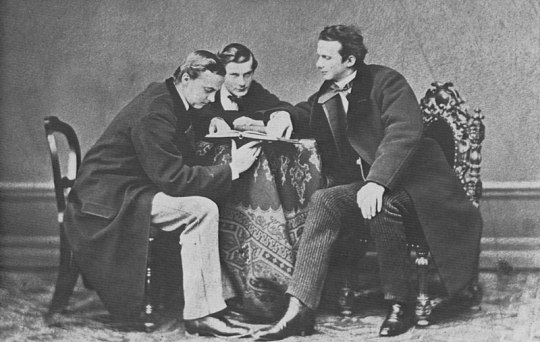
Joseph Albert
Wilhelm von Hessen-Darmstadt with Prince Otto and Ludwig II. of Bavaria in the studio of Joseph Albert
1863
#Joseph Albert#photography#1863#Prince Otto of Bavaria#Wilhelm von Hessen#Ludwig II#Bavaria#Germany#history
37 notes
·
View notes
Text
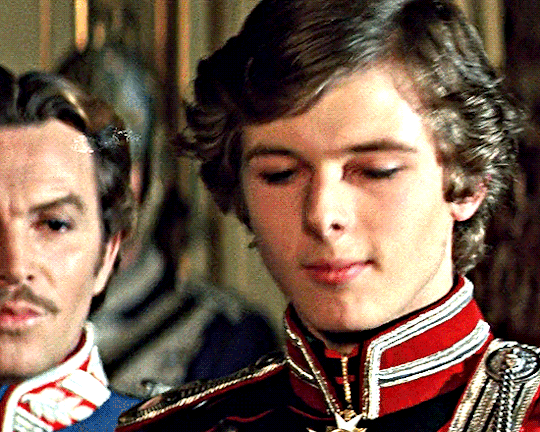

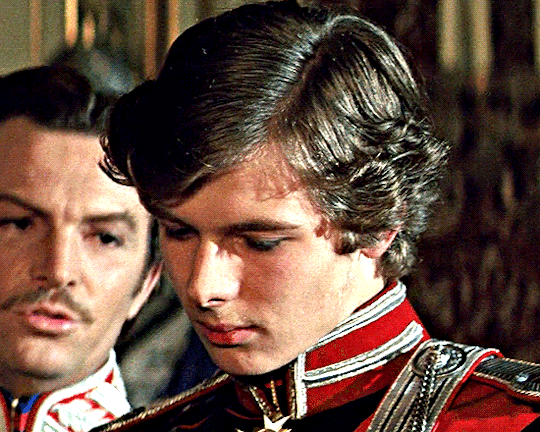
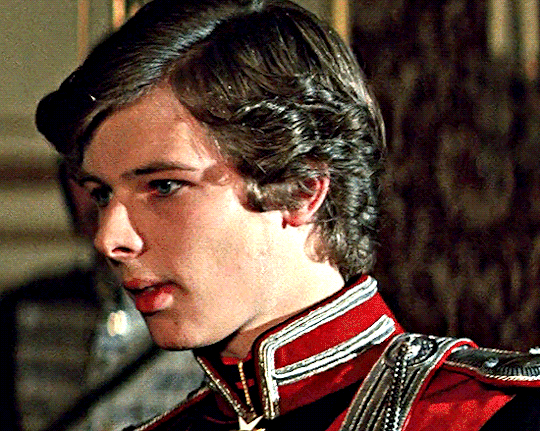
JOHN MOULDER-BROWN as PRINCE OTTO OF BAVARIA LUDWIG — 1972, Directed by Luchino Visconti
#oh no look! another lesser-known royal brother - who got overshadowed by a more famous brother - that i love! *pikachu face*#i'm so predictable but at least my taste is exceptional iktr#prince of bavaria you would've been besties with the duke of gandia#otto of bavaria#ludwig#ludwig ii#luchino visconti#john moulder brown#perioddramaedit#perioddramasource#cinemapix#dailyworldcinema#dailyflicks#actorsdaily#classicfilmcentral#classicfilmblr#classicfilmsource#filmgifs#fyeahmovies#by jen
223 notes
·
View notes
Text
anyone who watched this movie, will be quick to notice they are still in their roles on this photo from premier (I think it was held in the Hofgarten in Munich Residenz)
Otto is looking lost everything is bit too much all the spotlights, Ludwig is happy prince fairytale king with his bird and brilliant childlike smile, and Richard is boyfriend material aka trophy boyfriend. Richard is Kenough.

#ludwig ii#Ludwig ii movie#Ludwig ii 2012#sabin tambrea#tom schilling#prince otto#friedrich mücke#richard hornig#Germany#Bavaria#ludwig ii of bavaria#German cinematography#historical movie#And the parrot!!!#they are so cute#Sabin as ludwig chefs kiss#neuschwanstein castle#hohenschwangau#herrenchiemsee castle#Ludwig ii wittelsbach
28 notes
·
View notes
Note
Do you know about the potential marriage between Crown Prince Rudolf and Archduchess Maria Antonietta of the Tuscan branch? Read (unsure if it's accurate) how Emperor Franz Joseph I because of her tuberculosis, but reminds of Ludwig I of Bavaria initially opposing his third son Prince Luitpold marrying Archduchess Maria Antonietta's own aunt Augusta Ferdinanda who although died young, she did also bare four children who had long lives of their own.
Hello anon! This is a subject I've tried to look into, and honestly I find it equally frustrating and fascinating.


Many of Rudolf's biographers state that his first love was Archduchess Maria Antonietta, the only child of Ferdinando, last Grand Duke of Tuscany, by his first wife Princess Anna of Saxony. The story goes that they fell in love around 1878, and as you said, that she was considered a potential bride for the Crown Prince until her tuberculosis became evident. Some authors choose to end the story there, but others go even farther and talk of a secret marriage in 1880 - which would make Rudolf's marriage to Stephanie of Belgium in 1881 invalid. Maria Antonietta eventually died in 1883, at the age of 25.
But what these biographers sometimes don't mention is that in 1937 a man called Robert Pachmann claimed that he was Rudolf and Maria Antonietta's secret love child, born a month before the archduhcess' death, and that since his alleged parents had been legally married, he was the real head of the House of Habsburg and not Otto von Habsburg, Emperor Karl I's eldest son.
While before the invention of DNA tests it was very common that a person would randomly pop out claiming they were someone famous' lost child, what I find particularly interesting about this case is how FAR the Pachmanns went, going to trial several times, to the point that in 1965 Theodor Pachmann, Robert's son, was legally recognized as a Habsburg by a Vienese regional court, and again - even more explicitly - in 1976, when a judge ruled that he was a great-grandson of Franz Josef and Ferdinando of Tuscany. All these veredicts, however, were based solely on the testimony of Robert Pachmann's mother, who in 1925 stated that her son was actually Rudolf's and Maria Antonietta's. It was only in 2013 when two of Theodor's sons finally compared their DNA against a Habsburg: Georg Hohenberg, Archduke Franz Ferdinand's grandson. Which came out negative. Despite this, Robert Pachmann's descendants still claim to be descendants of Rudolf, mostly because they don't understand why Robert and Theodor would've spent so many years at court fighting for their case if it wasn't true [x].
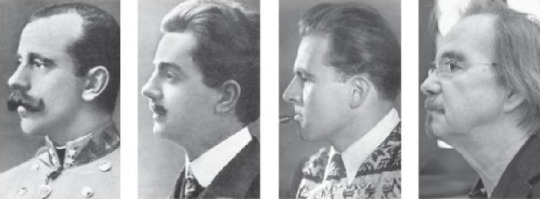
From left to right: Crown Prince Rudolf, Robert Pachmann, Theodor Pachmann and Rainer Pachmann (Theodor's son). From Alles aus Neugier: 40 Geschichten aus 40 Jahren by Georg Markus
At this point I was so down the rabbit hole that I thought, ok, there must have been some kind of rumor about Rudolf and Maria Antonietta, and Robert Pachmann built his story around that. After all, his descendants insist that there is evidence of a "love story" between them. But here is the thing: I can't find a single mention of a potential engagement or a rumored affair between Rudolf and Maria Antonietta from before Pachmann made his claim. In fact I can't even find a single mention of Rudolf and Maria Antonietta ever being in the same room together, though I assume they must have met at least once in court. Of course, just because I haven't found it doesn't mean it doesn't exist, so if any of you ever come across any sort of story (it doesn't matter if it's just rumors!) about Rudolf and Maria Antonietta from before 1937, please let me know!
#this story is actually insane imagine winning a court case based solely on your dead mother's testimony#crown prince rudolf of austria#archduchess maria antonietta of austria-tuscany#asks
12 notes
·
View notes
Text
The mystery of the Greek regalia has been solved...?
A mystery counting centuries was solved recently, when the Greek regalia, missing for many decades, were apparently discovered carefully stored in Tatoi Palace during its maintenance works.



The regalia of the Greek Kingdom were commissioned in Paris 1834, before the coronation of Otto of Greece. However, the regalia's transfer was delayed and Otto was coronated before they arrived at the country. As a result, Otto never actually used them but he did take them with him to Bavaria when he was exiled 30 years later.
The regalia reappeared almost a century after their creation when Albrecht von Wittelsbach, Prince of Bavaria, returned them to the Greek Kingdom during the wedding of King Paul of Greece to Frederica of Hanover, even though Paul belonged to a different house (Glücksburg).
The crown reportedly shortly appeared in the funerals of Paul and Frederica, however after that there was no more information on the whereabouts of the regalia. This led to conspiracy theories or even a conviction shared by historians and the public alike, which accused Constantine II, their son and last King of Greece, of sneaking the regalia out of the country and keeping them to himself, even though those belong to the Greek state and not a particular royal house.
Finally, the regalia were recently found carefully stored in Tatoi palace, outside Athens. This led to some re-evaluation of the theories blaming Constantine although some, including a significant historian, speculate that Constantine's descendants, sneaked the regalia back to the palace after the ex-King's death, to end these rumours casting a shadow over the ex-royal family.
The Greek regalia were commisioned to the French royal goldsmith house, Fossin et Fils, which had crafted the regalia of Napoleo Bonaparte. The sword was commissioned to the famed swordsmith Jules Manciaux. The regalia were made of gold, gilded metal and silver.
Otto tried to diverge a little from Bavarian archetypes for the designation of the regalia and establish a style slightly differing from the western kingdoms. The use of gems is very modest; only the sword is decorated with lapis lazuli. The decorative patterns refer directly to Greece, Christianity and the ancient greek culture. Lapis lazuli was chosen for its blue colour, the trademark colour associated with Greece. The sword case bears the Greek royal flag. The base has a sculpted presentation of a trident and two dolphins, as well as Goddess Nike (Victory).
The crown was very modest compared to most crowns in the west. Its base was crafted to look like a wreath of laurels. It has additional details of acanthus leaves and lion heads. The globus cruciger lies on the top of the crown and the cross resembles that of the Orthodox Church, unlike the ones in western kingdoms. In his own words, Otto had written to the architect Friedrich von Gürtner that his vision was for the architecture and designs used for him to be relatively strict, with noble dignity and simplicity.
The regalia will now be kept in the trophy hall of the Greek parliament.
Sources:
Newsbomb
Θέμα
11 notes
·
View notes
Text
Events 11.5 (before 1940)
1138 – Lý Anh Tông is enthroned as emperor of Vietnam at the age of two, beginning a 37-year reign. 1499 – The Catholicon, written in 1464 by Jehan Lagadeuc in Tréguier, is published; this is the first Breton dictionary as well as the first French dictionary. 1556 – Second Battle of Panipat: Fighting begins between the forces of Hem Chandra Vikramaditya, the Hindu king at Delhi and the forces of the Muslim emperor Akbar. 1605 – Gunpowder Plot: Guy Fawkes is arrested in the cellars of the Houses of Parliament, where he had planted gunpowder in an attempt to blow up the building and kill King James I of England. 1688 – Prince William III of Orange lands with a Dutch fleet at Brixham to challenge the rule of King James II of England (James VII of Scotland). 1757 – Seven Years' War: Frederick the Great defeats the allied armies of France and the Holy Roman Empire at the Battle of Rossbach. 1768 – The Treaty of Fort Stanwix is signed, the purpose of which is to adjust the boundary line between Indian lands and white settlements set forth in the Royal Proclamation of 1763 in the Thirteen Colonies. 1780 – French-American forces under Colonel LaBalme are defeated by Miami Chief Little Turtle. 1811 – Salvadoran priest José Matías Delgado rings the bells of La Merced church in San Salvador, calling for insurrection and launching the 1811 Independence Movement. 1828 – Greek War of Independence: The French Morea expedition to recapture Morea (now the Peloponnese) ends when the last Ottoman forces depart the peninsula. 1834 – Founding of the Free University of Brussels by Pierre-Théodore Verhaegen. 1862 – American Civil War: Abraham Lincoln removes George B. McClellan as commander of the Army of the Potomac. 1862 – American Indian Wars: In Minnesota, 303 Dakota warriors are found guilty of rape and murder of whites and are sentenced to death. Thirty-eight are ultimately hanged and the others reprieved. 1872 – Women's suffrage in the United States: In defiance of the law, suffragist Susan B. Anthony votes for the first time, and is later fined $100. 1881 – In New Zealand, 1600 armed volunteers and constabulary field forces led by Minister of Native Affairs John Bryce march on the pacifist Māori settlement at Parihaka, evicting upwards of 2000 residents, and destroying the settlement in the context of the New Zealand land confiscations. 1895 – George B. Selden is granted the first U.S. patent for an automobile. 1898 – Negrese nationalists revolt against Spanish rule and establish the short-lived Republic of Negros. 1911 – After declaring war on the Ottoman Empire on September 29, 1911, Italy annexes Tripoli and Cyrenaica. 1912 – Woodrow Wilson is elected the 28th President of the United States, defeating incumbent William Howard Taft. 1913 – King Otto of Bavaria is deposed by his cousin, Prince Regent Ludwig, who assumes the title Ludwig III. 1914 – World War I: France and the British Empire declare war on the Ottoman Empire. 1916 – The Kingdom of Poland is proclaimed by the Act of 5th November of the emperors of Germany and Austria-Hungary. 1916 – The Everett massacre takes place in Everett, Washington as political differences lead to a shoot-out between the Industrial Workers of the World organizers and local police. 1917 – Lenin calls for the October Revolution. 1917 – Tikhon is elected the Patriarch of Moscow and of the Russian Orthodox Church. 1925 – Secret agent Sidney Reilly, the first "super-spy" of the 20th century, is executed by the OGPU, the secret police of the Soviet Union.
1 note
·
View note
Photo

The Greek War of Independence, also known as the Greek Revolution, was a successful war of independence waged by Greek revolutionaries against the Ottoman Empire between 1821 and 1830. The Greeks were later assisted by Great Britain, France and Russia, while the Ottomans were aided by their North African vassals, particularly the eyalet of Egypt. The war led to the formation of modern Greece. The revolution is celebrated by Greeks around the world as independence day on 25 March.
Greece came under Ottoman rule in the 15th century, in the decades before and after the fall of Constantinople. During the following centuries, there were sporadic but unsuccessful Greek uprisings against Ottoman rule. In 1814, a secret organization called Filiki Eteria (Society of Friends) was founded with the aim of liberating Greece, encouraged by the revolutionary fervor gripping Europe in that period. The Filiki Eteria planned to launch revolts in the Peloponnese, the Danubian Principalities, and Constantinople itself. The insurrection was planned for 25 March 1821 (on the Julian Calendar), the Orthodox Christian Feast of the Annunciation. However, the plans of Filiki Eteria were discovered by the Ottoman authorities, forcing the revolution to start earlier. The first revolt began on 6 March/21 February 1821 in the Danubian Principalities, but it was soon put down by the Ottomans. The events in the north urged the Greeks in the Peloponnese (Morea) into action and on 17 March 1821, the Maniots were first to declare war. In September 1821, the Greeks under the leadership of Theodoros Kolokotronis captured Tripolitsa. Revolts in Crete, Macedonia, and Central Greece broke out, but were eventually suppressed. Meanwhile, makeshift Greek fleets achieved success against the Ottoman navy in the Aegean Sea and prevented Ottoman reinforcements from arriving by sea.
Tensions soon developed among different Greek factions, leading to two consecutive civil wars. The Ottoman Sultan called in his vassal Muhammad Ali of Egypt, who agreed to send his son Ibrahim Pasha to Greece with an army to suppress the revolt in return for territorial gains. Ibrahim landed in the Peloponnese in February 1825 and brought most of the peninsula under Egyptian control by the end of that year. The town of Missolonghi fell in April 1826 after a year-long siege by the Turks. Despite a failed invasion of Mani, Athens also fell and the revolution looked all but lost.
At that point, the three Great powers—Russia, Britain and France—decided to intervene, sending their naval squadrons to Greece in 1827. Following news that the combined Ottoman–Egyptian fleet was going to attack the island of Hydra, the allied European fleets intercepted the Ottoman navy at Navarino. After a tense week-long standoff, the Battle of Navarino led to the destruction of the Ottoman–Egyptian fleet and turned the tide in favor of the revolutionaries. In 1828 the Egyptian army withdrew under pressure of a French expeditionary force. The Ottoman garrisons in the Peloponnese surrendered, and the Greek revolutionaries proceeded to retake central Greece. Russia invaded the Ottoman Empire and forced it to accept Greek autonomy in the Treaty of Adrianople (1829). After nine years of war, Greece was finally recognized as an independent state under the London Protocol of February 1830. Further negotiations in 1832 led to the London Conference and the Treaty of Constantinople; these defined the final borders of the new state and established Prince Otto of Bavaria as the first king of Greece.
The consequences of the Greek revolution were somewhat ambiguous in the immediate aftermath. An independent Greek state had been established, but with Britain, Russia and France having significant influence in Greek politics, an imported Bavarian dynast as ruler, and a mercenary army. The country had been ravaged by ten years of fighting and was full of displaced refugees and empty Turkish estates, necessitating a series of land reforms over several decades.
The population of the new state numbered 800,000, representing less than one-third of the 2.5 million Greek inhabitants of the Ottoman Empire. During a great part of the next century, the Greek state sought the liberation of the “unredeemed” Greeks of the Ottoman Empire, in accordance with the Megali Idea, i.e., the goal of uniting all Greeks in one country.
As a people, the Greeks no longer provided the princes for the Danubian Principalities, and were regarded within the Ottoman Empire, especially by the Muslim population, as traitors. Phanariotes, who had until then held high office within the Ottoman Empire, were thenceforth regarded as suspect, and lost their special, privileged status. In Constantinople and the rest of the Ottoman Empire where Greek banking and merchant presence had been dominant, Armenians mostly replaced Greeks in banking, and Jewish merchants gained importance.
In the long-term historical perspective, this marked a seminal event in the collapse of the Ottoman Empire, despite the small size and the impoverishment of the new Greek state. For the first time, a Christian subject people had achieved independence from Ottoman rule and established a fully independent state, recognized by Europe. Whereas previously, only large nations (such as the Prussians or Austrians) were judged worthy of national self-determination by the Great Powers of Europe, the Greek Revolt legitimized the concept of small, ethnically-based nation-states, and emboldened nationalist movements among other subject peoples of the Ottoman Empire. The Serbs, Bulgarians, Albanians, Romanians and Armenians all subsequently fought for and won their independence.
Shortly after the war ended, the people of the Russian-dependent Poland, encouraged by the Greek victory, started the November Uprising, hoping to regain their independence. The uprising, however, failed, and Polish independence had to wait until 1918 at Versailles. The newly established Greek state would become a catalyst for further expansion and, over the course of a century, parts of Macedonia, Crete, Epirus, many Aegean Islands, the Ionian Islands and other Greek-speaking territories would unite with the new Greek state. The Greek rebels won the sympathy of even the conservative powers of Europe.
Daily inspiration. Discover more photos at http://justforbooks.tumblr.com
18 notes
·
View notes
Text

King Ludwig I of Bavaria with his Family, Jointly Examining the Painting ‘The Arrival of King Otto of Greece into Napflio"
Artist: Peter von Hess (German, 1792-1871)
Date: 1835
Ludwig I or Louis I (25 August 1786 – 29 February 1868) was King of Bavaria from 1825 until the 1848 revolutions in the German states. When he was crown prince, he was involved in the Napoleonic Wars. As king, he encouraged Bavaria's industrialization, initiating the Ludwig Canal between the rivers Main and the Danube. In 1835, the first German railway was constructed in his domain, between the cities of Fürth and Nuremberg, with his Bavaria joining the Zollverein economic union in 1834. After the July Revolution of 1830 in France, Ludwig's previous liberal policy became increasingly repressive; in 1844, Ludwig was confronted during the Beer riots in Bavaria. During the revolutions of 1848 the king faced increasing protests and demonstrations by students and the middle classes. On 20 March 1848, he abdicated in favour of his eldest son, Maximilian.
Ludwig lived for another twenty years after his abdication and remained influential. An admirer of ancient Greece and the Italian Renaissance, Ludwig patronized the arts and commissioned several neoclassical buildings, especially in Munich. He was an avid collector of arts, amassing paintings from the Early German and Early Dutch periods as well as Graeco-Roman sculptures.
All living legitimate agnatic members of the House of Wittelsbach descend from him.
#portrait#peter von hass#king ludwig i of bavaria#royal family#bavarian family#19th century bavaria#family#artwork#drapery#german painter#king of bavaria#bavarian royal family#19th century art
1 note
·
View note
Text
Ludwig II — Glanz und Ende eines Königs (1955) [Ludwig II — Lustre and End of a King]
Honestly, this might be my favorite so far. Which I guess isnt great because while Elisabeth does play a fairly large role, this is hardly what I would call a Sissi-film. If you're wondering why this film was even on my list, when I was looking for all the media I was going to watch, I started on wikipedia which listed this film and when I briefly skimmed the summary, I determined that it had enough Elisabeth in it to make the cut. There are a few other pieces of media like Der Engel mit der Posaune (1948) where I skimmed the summary and determined there wasnt enough of either her or Rudolf in it, its kinda arbitrary if Im being honest, but yeah. hope you enjoyed this little look behind the curtain.
Anyway, I liked this movie a lot and it didnt even have a One Big Issue like Mayerling (1936) did. I will admit, a big part of it is that it was just very refreshing seeing a movie about a different kind of mentally ill man (who also didnt have a lot going on in the romance department, thank god) after all these Rudolf-movies, but I promise that's not the only reason I like it so much
It's kind of hard to give a plot summary because this film is essentially just a series of vignettes from when Ludwig was 25 (?) up to his death, but despite having no real overarching 'plot' like Elisabeth von Österreich (1931), it doesnt suffer from any of the same issues, like the vignettes feeling disconnected and random, because it's actually a really good character study. But anyway, in lieu of writing a summary, Im just gonna describe my four favorite moments:
When Bavaria is set to go to war, his ministers want him to give a speech to his soldiers and he refuses by giving this sortof mock-speech where he's like "you're going to war where you will kill your brothers who are now your enemies and be killed by your enemies that were once your brothers. to those of you who will be killed, may your death be quick at least", its a lot longer than that and Im doing a bad job paraphrasing it but hes basically conveying that if he's forced to give a speech to the soldiers that he didnt want to send off to war in the first place, he'll say a bunch of shit that will crush their morale, so the ministers leave him alone. I think this scene does a good job showing the audience some of Ludwig's depth and that he's not just a romantic, and the way O. W. Fischer delivered that whole monologue was really great too
After getting engaged to Sophie, he takes her to see an opera but when they actually get there and sit down in their box, she sees that the opera house is completely empty save for the musicians. Ludwig set it up like this so he could show her the loneliness he feels all the time and the disconnect from other people and what she would have to endure if she married him, she finds it absolutely horrible and spoiler alert, but they break off the engagement and dont talk to each other for the rest of the film after this. I find this scene very interesting and I can just imagine how mortifying it would be to be completely alone in this giant opera building, but I feel like they couldve done a better job conveying what Ludwig and Sophie feel through the filmmaking
After the first major timeskip of the film, Elisabeth visits Ludwig (this is during that time period where she traveled around a lot and was difficult to get a hold of) and they just talk for a bit, I find it difficult to summarize because theyre not really talking about one specific thing that you can just name, but I think it gives her and their relationship a lot of depth, and its the scene that made me really like Ruth Leuwerik as Elisabeth, I wasnt sure if I would like her at the start and while she's not my favorite, I thought she was good
Ludwig is supposed to greet the crown prince of Prussia whos arriving in Bavaria but he refuses, then his younger brother Otto comes in to try and comvince him as well and he starts by telling him about what it felt like to be there as this new country "Germany" was founded, but he ends up having what appears to be a ptsd-flashback from the loud music being played outside and Ludwig tries to comfort him but he ends up collapsing. I cannot stop thinking about this scene, its so heart-wrenching and upsetting and O. W. Fischer and Klaus Kinski's performances are both absolutely phenomenal. And then Ludwig calls over a psychiatrist/doctor to check on him, but all of his ministers are bothering him trying to get him to greet the crown prince, and throughout all of this theres still this cheerful/triumphant music blaring outside, I think it does such a good conveying the disconnect between Ludwig as a person and his duties and what's being expected of him
Also, and this isnt just one scene the way the other things I mentioned are so I didnt want to put it in the list above, but theres this short plotline at the start of the film where Ludwig basically picks composer Richard Wagner out of poverty and showers him with a bunch of money because he admires him so much, and I just wanted to say that theres such a strong homoerotic tension between those two. Like, the scene where they meet in person for the first time is so unbelievably intense, its this long moment of silence that gets broken by Richard and then Ludwig tells him something so incredibly poetic and beautiful, I dont remember what exactly it was but it made my jaw drop a little, and then he kisses him on the cheek ?? and yes, men kissing each other on the cheek was normal at the time, Ludwig even kissed Franz Joseph earlier in the film, but I swear its different when he kisses Richard, its so intimate and full of love and the music swells and everything, I was not expecting that at all
I mean, to be fair, most of the scenes where he interacts positively with someone else are full of a kind of tension-filled love, but still
Anyway, Ive already talked about how great O. W. Fischer was as Ludwig, but I just really need to highlight it again; he was so charismatic towards the beginning, but I also think he did a wonderful job portraying Ludwig's nuances and him slowly unraveling over the course of the film. Also, he reminds me of the actor who played Freder in Metropolis (1927), especially for that beginning section where he doesnt have facial hair yet, they both have this babygirlishness that I really love in a man. Now, unfortunately I do think he loses that as the film goes on, but thats mainly because I dont like facial hair, Im sure plenty of you guys can still appreciate his babygirlishness during the later sections as well
Other than that, I thought the sets looked really beautiful and apparently they did film a lot of the scenes on-location which is really cool. However, I cant talk about the sets without talking about this one scene where Ludwig and Elisabeth talk in the mirror hall in Neuschwanstein because it looks so bad. I'm 99.9% sure they used an old-timey greenscreen-thing for it (I forgot the actual name but I think it was either whitescreen or lightscreen), presumably because actually filming in a big room full of mirrors without having the cameras show would have been really hard, but god. They also used it for an earlier scene where Ludwig and Elisabeth went horseriding together, and it looks comically bad as well
So yeah, this is a very good film, it makes me excited for the other Ludwig/Elisabeth film I have on my list, and it genuinely makes me want to seek out more films about Ludwig II (if there are any more lol) but Im kinda busy rn so that'll have to wait.
Now for the two small things I couldnt fit into the rest of the post:
I found the austrian dialects everyone had very charming, which technically applies to every austrian talkie Ive seen so far and not just this one, but Ive never mentioned it so I figured I might as well do it now
I couldnt help but notice a lot of the male character's wonderful silhouettes and I have but one thing to say: bring back slut waists for guys
1 note
·
View note
Text

It appears Duke Konrad of Luxembourg hasn't given up hope on becoming the Kaiser of the HRE again, creating a strong faction to install himself on the Holy Roman Throne.

Unlike his sister Princess Beatrice, Queen Matilda inducts Prince Goffredo into the service of the Horned God and makes him a secret Witch.
Hopefully, his Witch secret will not be revealed before we get to play as Prince Goffredo as being a Witch is a criminal offence which invites imprisonment by his Liege, who is Duke Konrad of Luxembourg.

As part of her mandate as Regent of the HRE, Queen Matilda attempts to recruit a rare talent named Ruggiero di Rienzo who is quite the fighter at 17 prowess. Despite the fact that Queen Matilda's words sway him and her Scales of Power swing by 5 towards her, Ruggiero vanishes without a trace and cannot be found in Emperor Zoltan's court thereafter.

Queen Matilda's Executioner, Jakob Jorstedt and her Master of the Hunt and Acclaimed Knight, Biagio di Pontio harbour an intense dislike and rivalry between them for a long time. That is when Biagio challenged Jakob to a duel to prove who is Queen Matilda's foremost knight. Queen Matilda quickly intervenes to take their swords and give them training blades for the duel.

Otto von Nordheim, who is Queen Matilda's hostage from Duke Heinrich IX of Bavaria, has grown up to become a Content, Gluttonous, Brave and Naive Appeaser. We return the hostage to the Duke of Bavaria since Otto has turned 16.



Meanwhile, Prince Goffredo turns 16 as well, becoming an Intricate Webweaver. Queen Matilda quickly makes him marry Tatyana Rurikid, daughter of Grand Prince Vladimir of Pereyaslavl, both of whom are Othrodox Russians and Geniuses.
0 notes
Text
JANE DIGBY // ARISTOCRAT
“She was an English aristocrat, famed for her remarkable love life and lifestyle. She had four husbands and many lovers, including Lord Ellenborough, Governor-General of India, King Ludwig I of Bavaria and his son King Otto of Greece, Bohemian nobleman and Austrian statesman Prince Felix zu Schwarzenberg, and the Greek general Christodoulos Hatzipetros. She died in Damascus, Syria, as the wife of Arab Sheikh Medjuel el Mezrab, who was 20 years her junior.”


0 notes
Text
being a pr manager for the underrated, abandoned, and misunderstood royal younger sibling who is overshadowed by their more famous older sibling is my whole personality at this point
#yes i'm talking to you prince otto of bavaria (ludwig ii's brother) and you too juan borgia (cesare borgia's brother)#because aside of having compelling personalities and aspects...who's gonna hype them if i didn't 😔#otto of bavaria#ludwig ii#juan borgia#george plantagenet#ernest ii#and many more omfg but the fact that mostly are played by david oakes is fascinating#david oakes#john moulder brown#text post
17 notes
·
View notes
Text
“A queen from a fairy tale in which none but she believed”


Searching for information about Queen Marie Sophie of the Two Sicilies in the Archive, as one does, I came across a book called Portraits with backgrounds, written by sculptor Catherine Barjansky and published in 1947. I couldn't find much information on Catherine, only that she was born in 1890 in Odessa and moved to Munich in 1910 to study sculpture. She lived in several countries with her husband the cellist Alexandre Barjansky, whom she married in 1914, and after they separated in 1940 she moved to New York, where she lived for the rest of her life, dying in 1965.
Queen Marie was one of Catherine's many sitters. She dedicates the half of chapter five of her book to the deposed queen, which is by far the most detailed account of Marie as an old woman that I've ever come across. The entry is long, so I divided it in two parts. In this first part, Catherine narrates her first meeting with the last queen of the Two Sicilies in Switzerland, 1914:
A PHANTOM QUEEN AND A TORRENT OF MUSIC “HER Majesty the Queen will appear in a few minutes,” whispered the Comtesse de la Tour, lady in waiting to the Queen of Naples. How strange those words sounded in that conventional living room in the little hotel in Geneva! For the Queen of whom the little white-haired lady in waiting spoke with such ceremony had lost her throne fifty years before. Few people even remembered the Kingdom of Naples. The very existence of this woman was an historical anachronism. But not to the Comtesse de la Tour who, by a personal act of faith, managed to turn an ordinary hotel suite into a royal palace. Never having met a queen before, I did not know how to behave nor what was expected of me. And this queen, even in exile, perhaps because of her exile, was punctilious about etiquette. On the journey from Lausanne I had bombarded my husband with questions. What was she like? She was a very unusual woman, he said. She would interest me. He had met her first in Paris, where she had a charming house and occasionally received artists, among them Caruso who was a great friend of hers. Even there, Alexandre said, where she could walk unknown through the streets, she lived as though she were surrounded by high walls, remote from the world, untouchable. Several months of each year she spent in Munich because the Prince-Regent of Bavaria was a relative of hers. At that time, King Otto of Bavaria was in a sanitarium.
The door opened. The ghost of a woman stood there for a moment and then came forward swiftly. She was very tall, with a face as narrow as a knife blade; a body as thin, as narrow, as unsubstantial as a shadow. It was the body of a skeleton. She wore a long simple black dress with a high collar, her long neck swathed in tulle, under which gleamed a necklace of huge pearls. Her hands were almost transparent, with incredibly long fingers. Her eyes were pale blue and seemed to give out a blue light. Her nose was thin and long, her lips thin and expressive. Her hair was white with two heavy braids, which, surprisingly enough, were almost black, wrapped around her head, forming a sort of crown over her high forehead. She smiled, and the severe expression of her face altered, became softer, and even kind in a detached way. She gave me her long pale hand, and for the first time in my life I made a deep curtsy. My husband bowed and kissed her hand, and she seated herself, very erect, not touching the back of her chair. She sat on the ordinary hotel chair as though she were on a throne, and held her head as though her black braids were really a royal crown. It was an imaginary crown, but one of which she was conscious every moment of her life.
All that afternoon we sat in the little hotel room, while she carried on a conversation with my husband, and I, aside from answering an occasional question, was silent and studied her. She was gracious and kind, but she was a phantom woman on a cloud, remote from the rest of humanity. She was a being from the past, a ghost, a queen from a fairy tale in which none but she believed. She went through life holding high her head with its imaginary crown and conscious of an enormous distance between her and ordinary people, because she was not real.
Since then I have met other crowned heads in Europe; but always, when I think of a queen, it is of the Queen of Naples who lived for fifty years in exile, without a throne, without a country, with nothing but a dream to comfort her.
At length I gathered together my courage and asked whether she would let me bring some wax and do her portrait. “Oh, yes,” she said readily. “The Comtesse will write to you.”
#another day wishing there were good pics of marie at old age#there are some of her with franz josef in 1907 but you can't see her face properly in those :(#queen marie sophie of the two sicilies#catherine barjansky#portraits with backagrounds
15 notes
·
View notes
Text
#i did not know about this but it sounds like a fantastic plot for a historical novel of some sort!#history via @sunflowerjune
For example...
Leopold I of Belgium:
The youngest son of Francis, Duke of Saxe-Coburg-Saalfeld, Leopold took a commission in the Imperial Russian Army and fought against Napoleon after French troops overran Saxe-Coburg during the Napoleonic Wars. After Napoleon's defeat, Leopold moved to the United Kingdom, where in 1816 he married Princess Charlotte of Wales, the only child of the Prince Regent (the future King George IV). Leopold and Charlotte's marriage was happy, but it ended after a year and a half when Charlotte died after delivering a stillborn son. Leopold continued to enjoy considerable status in Britain. After the Greek War of Independence (1821–1830), Leopold was offered the throne of Greece under the 1830 London Protocol that created an independent Greek state, but turned it down, believing it to be too precarious. Instead, he accepted the throne of Belgium in 1831 following the country's independence in 1830.
Otto of Greece:
At the end of Greek War of Independence, the three Great Powers formulated the London Protocol of 1829, which recognized an autonomous Greek state. Article 3 of the protocol stated that Greece would be a monarchy, under the rule of a prince who was not from the ruling families of one of the three Great Powers.[4] Numerous candidates were considered for the vacant throne, including Prince Frederick of the Netherlands and Otto's uncle, Prince Karl Theodor of Bavaria. Even an Irishman named Nicholas Macdonald Sarsfield Cod'd put himself forward, claiming descent from the Byzantine Palaiologos dynasty.[5] Ultimately, they settled on Prince Leopold of Saxe-Coburg and Gotha, and the amended London Protocol of 1830 recognized him as the de jure sovereign of Greece. Although initially enthusiastic, Leopold was discouraged by the limited borders established by the protocol and Britain's refusal to grant financial support to the vulnerable new state. Due to this, as well as personal reasons, he formally rejected the crown three months later.[6] Kapodistrias' assassination in 1831 destabilized Greece, and caused British Foreign Secretary Lord Palmerston to convene the London conference. Here, the crown was offered to the 17-year-old Prince Otto, which he happily accepted. The Bavarian House of Wittelsbach had no connections to the ruling dynasties of any of the Great Powers, and so was a neutral choice with which they were all satisfied. The Greeks were not consulted, but Greece was in chaos and no group or individual could claim to represent it anyway.[7] The London Protocol of 1832 therefore finally recognized Greece as a fully independent state, with Otto as its king.
Maximillian of Mexico:
Two years before his dismissal, he briefly met with French emperor Napoleon III in Paris, where he was approached by conservative Mexican monarchists seeking a European royal to rule Mexico.[2] Initially Maximilian was not interested, but following his dismissal as viceroy, the Mexican monarchists' plan was far more appealing to him. Since Maximilian was a descendant of Charles V, Holy Roman Emperor, King of Spain when the Spaniards conquered the Aztecs (1519–21) and first brought Mexico into the Spanish Empire, a status it held until the Mexican independence in 1821, Maximilian seemed a perfect candidate for the conservatives' plans for monarchy in Mexico.[3] Maximilian was interested in assuming the throne, but only with guarantees of French support. Mexican conservatives did not take sufficient account of Maximilian's embrace of liberalism, and Maximilian failed to understand he would be viewed as a foreign outsider.[4] When Maximilian was first mentioned as a possible emperor of Mexico, the idea seemed farfetched, but circumstances changed and made it viable. His tenure as emperor was just three years, ending with his execution by firing squad by forces of the Restored Republic on 19 June 1867.
The Argentinian thing was less defined -for a time Alvear tried to negotiate a protectorate with the British crown, and at some other point Carlota Joaquina of Spain (wife of the first emperor of Brazil) was interested in some sort of Río de la Plata kingdom, but it never came anywhere near to becoming a reality.
There are few things as wodehousian as that weird period in the 1800s where several nations were looking to hire royals to become their princes/kings/emperors.
#long post#history#Otto of Greece does absolutely sound like one of those not very bright but friendly#(and strapped for cash) lords from Wodehouse novels
37 notes
·
View notes
Text
Events 11.5 (before 1920)
1138 – Lý Anh Tông is enthroned as emperor of Vietnam at the age of two, beginning a 37-year reign. 1499 – The Catholicon, written in 1464 by Jehan Lagadeuc in Tréguier, is published; this is the first Breton dictionary as well as the first French dictionary. 1556 – Second Battle of Panipat: Fighting begins between the forces of Hem Chandra Vikramaditya, the Hindu king at Delhi and the forces of the Muslim emperor Akbar. 1605 – Gunpowder Plot: Guy Fawkes is arrested in the cellars of the Houses of Parliament, where he had planted gunpowder in an attempt to blow up the building and kill King James I of England. 1688 – Prince William III of Orange lands with a Dutch fleet at Brixham to challenge the rule of King James II of England (James VII of Scotland). 1757 – Seven Years' War: Frederick the Great defeats the allied armies of France and the Holy Roman Empire at the Battle of Rossbach. 1768 – The Treaty of Fort Stanwix is signed, the purpose of which is to adjust the boundary line between Indian lands and white settlements set forth in the Royal Proclamation of 1763 in the Thirteen Colonies. 1780 – French-American forces under Colonel LaBalme are defeated by Miami Chief Little Turtle. 1811 – Salvadoran priest José Matías Delgado rings the bells of La Merced church in San Salvador, calling for insurrection and launching the 1811 Independence Movement. 1828 – Greek War of Independence: The French Morea expedition to recapture Morea (now the Peloponnese) ends when the last Ottoman forces depart the peninsula. 1862 – American Civil War: Abraham Lincoln removes George B. McClellan as commander of the Army of the Potomac. 1862 – American Indian Wars: In Minnesota, 303 Dakota warriors are found guilty of rape and murder of whites and are sentenced to death. Thirty-eight are ultimately hanged and the others reprieved. 1872 – Women's suffrage in the United States: In defiance of the law, suffragist Susan B. Anthony votes for the first time, and is later fined $100. 1895 – George B. Selden is granted the first U.S. patent for an automobile. 1898 – Negrese nationalists revolt against Spanish rule and establish the short-lived Republic of Negros. 1911 – After declaring war on the Ottoman Empire on September 29, 1911, Italy annexes Tripoli and Cyrenaica. 1912 – Woodrow Wilson is elected the 28th President of the United States, defeating incumbent William Howard Taft. 1913 – King Otto of Bavaria is deposed by his cousin, Prince Regent Ludwig, who assumes the title Ludwig III. 1914 – World War I: France and the British Empire declare war on the Ottoman Empire. 1916 – The Kingdom of Poland is proclaimed by the Act of 5th November of the emperors of Germany and Austria-Hungary. 1916 – The Everett massacre takes place in Everett, Washington as political differences lead to a shoot-out between the Industrial Workers of the World organizers and local police. 1917 – Lenin calls for the October Revolution. 1917 – Tikhon is elected the Patriarch of Moscow and of the Russian Orthodox Church.
1 note
·
View note
Photo

The House of Wittelsbach has been terribly ravaged by insanity. In the course of one hundred years more than twenty members of the family have been visited by this misfortune. The sons of Maximilian II were burdened with exceedingly neurotic tendencies. Their grandfather had been eccentric in a high degree; and a sister of King Maximilian was for long retained in a madhouse.
At the beginning of 1872 the newspapers began to insert notices in their columns to the effect that Prince Otto of Bavaria was suffering. In the fifties and sixties he had been the picture of health. Where Ludwig had withdrawn, he had gone forward towards people with outstretched hands. He had always been gay, amiable, and lively. The unnaturally strict upbringing, and the rapidity with which, from the almost unendurable restraint, he had been thrown into unfettered freedom, had, however been a concurrent cause of his losing his mental balance. Hardly two and twenty years of age, he had followed the army (1870). We know that, depsite his wish to remain with it, the King had recalled him to Hohenschwangau. The summons was probably the dictate of the elder brother's personal fellings; but the Prince's nervous system had also shown itself to be unfitted for the bloody scenes of a battlefield.
Biography of Ludwig II, 1908
19 notes
·
View notes